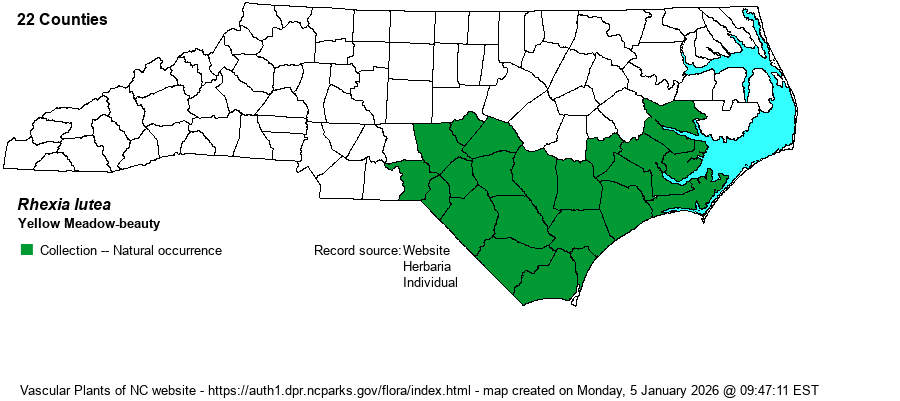| Author | Walter | |
| Distribution | Throughout the southern half of the Coastal Plain, including the Sandhills region. Ranges north to Beaufort, Harnett, Lee, and Moore counties.
This is a Coastal Plain species, ranging from southeastern NC south to central FL and west to eastern TX.
| |
| Abundance | Infrequent to locally fairly common (in well-managed pinelands) in the southern coastal counties from Craven and Carteret to the SC border. Rare to uncommon in the Sandhills region and counites away from major Longleaf Pine (Pinus palustris) stands. Despite the range map containing no gaps in counties with collections, this is not as common as one might imagine, and it is by no means a frequently seen species. | |
| Habitat | This is a classic pine savanna species, but it also grows in wetter portions of pine flatwoods, sandhills seeps, wet spots in powerline clearings that mimic a savanna, and other damp ground associated with pines, mostly with Longleaf Pine. |
| Phenology | Blooms from April to July -- earlier than most others in the genus, and fruits soon after flowering. | |
| Identification | This is the only yellow-flowered Rhexia, which would seemingly make it obvious to identify. However, at some distance, one or two Oenothera species can look like it in flower, and if not in bloom, it might be tricky to identify. It is normally a hairy species, with a much-branched stem, growing to 1-1.5 feet tall. The paired stem leaves are quite variable in shape, but are often narrow, 3-nerved, and mostly oblong, elliptic, to nearly linear, about 2 inches long and usually 1/4-inch wide or less. The flowers from the branch tips and upper axils are quite spectacular and are not normally just a medium yellow but are a rich, golden-yellow, with the 4 rounded but irregular petals having a spread flower about 1-inch across, usually a bit smaller than in many rose-flowered species. This species has a rather short/small capsule, generally smooth and with a quite short neck. Do not try to identify the species when not in bloom, just from the leaves and stem, but the short capsule with a narrow neck might help you identify it. Of course, when seen in bloom, with the bright golden-yellow flowers, no guesswork is needed; Oenothera flowers can be bright yellow, but they have no hypanthium behind the petals, and the leaves are alternate on the stem. | |
| Taxonomic Comments | None
| |
| Other Common Name(s) | Golden Meadow-beauty | |
| State Rank | S4 | |
| Global Rank | G5 | |
| State Status | | |
| US Status | | |
| USACE-agcp | FACW link |
| USACE-emp | FACW link |

